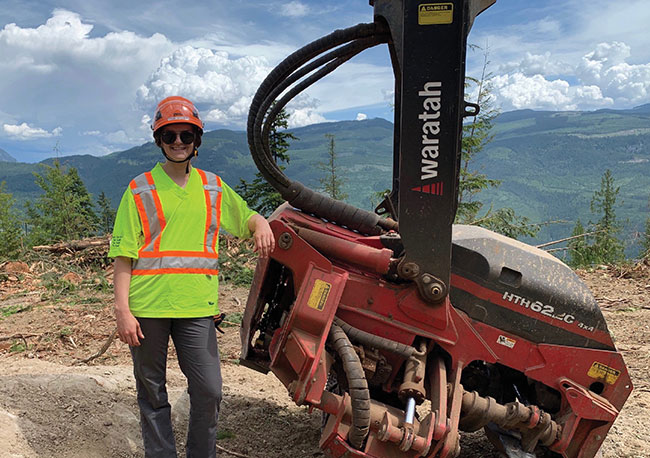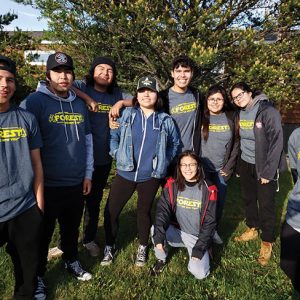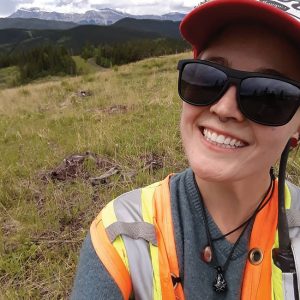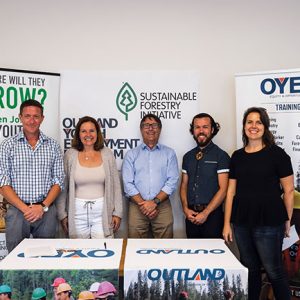
Features
Project Learning Tree changes the forestry conversation for future forest leaders
PLT Canada works to engage youth through Green Jobs, mentorship initiatives
July 16, 2020 By David Folkerson
 Tara Griener worked with Interfor Corporation as a planning assistant in 2019. She assisted a senior forester with timber evaluation, road design, and cut block layout. Photo courtesy Tara Griener.
Tara Griener worked with Interfor Corporation as a planning assistant in 2019. She assisted a senior forester with timber evaluation, road design, and cut block layout. Photo courtesy Tara Griener. Like many sectors of the Canadian economy, forestry is facing a wave of retirements as baby boomers leave the workforce. According to 2019 Statistics Canada labour force data, only about 10 per cent of workers in the “forestry and logging and support activities for forestry” category are between the ages of 15 and 24.
This demographic shift means there are some tremendous opportunities for youth to establish themselves in rewarding careers in forestry. But in my work in the sector I’m often confronted with perceptions that are getting in the way of youth embracing forestry.
The forest sector is green and sustainable, but many young Canadians don’t know this. That’s one of the findings of the Future of Forestry Think Tank hosted by the City of Quesnel, B.C., with support from the government of Canada and the province of British Columbia. It’s also a fact that most of my forest sector colleagues would agree with, even though we all know the sector offers some of the greenest, most technically advanced career opportunities in Canada.
That’s why Project Learning Tree Canada (PLT Canada) is working to change the conversation around youth and forests. This conversation helps support the Sustainable Forestry Initiative (SFI) goal of addressing myriad global sustainability challenges through solutions that include youth-focused activities. PLT Canada, an initiative of SFI, is working to help youth become leaders who will make better choices for our planet.
Since 2018, we have placed youth in over 2,000 Green Jobs across the country. These youth gained valuable experience that will help them pursue careers as foresters, wildlife biologists, Indigenous knowledge coordinators, hydrologists, park rangers, and more.
“I learned a great deal about managing for endangered wildlife and the best environmental practices to
work sustainably,” says Tara Griener, a planning assistant with Interfor Corporation, an SFI-certified organization, about her experience.
“Learning about what kinds of site preparation and other techniques work best has really helped me to understand what ways work and which don’t in regenerating a forest,” adds Zena Martin, a forestry summer student with West Fraser Timber Co., an SFI-certified organization.
To place these youth, we directly engaged with over 200 different employers in our network across 12 provinces and territories. About one in four jobs went to rural youth, and 12 per cent of these jobs were filled by Indigenous youth. We are also proud of the fact that we achieved gender balance every year since we began the program.
Surveying youth and employers also tells a tale of success: following the program, 93 per cent of youth would consider a career in the green sector, and 98.5 per cent of employers believe the program increased their opportunities to hire youth.
These jobs inspire leadership in forest stewardship, foster a passion for science-based research and education, and help youth gain skills and experience so they can transition successfully into the labour market.
Green Jobs E-Summit
As part of our work to place youth in Green Jobs, we hosted a Green Jobs E-Summit, in partnership with the government of Canada’s Youth Employment and Skills Strategy, on April 2. Over 100 attendees joined forest and conservation sector professionals from SFIcertified organizations and partners across Canada to learn about the diversity of green career pathways, the life of a forester, why conservation jobs matter, tracking grizzlies, and how a green job could help prevent invasive species.
Originally scheduled as a two-day, in-person event, our first-ever Green Jobs E-Summit went online because of COVID-19 concerns. It was an important opportunity for participants to learn about the skills they will need to be successful.
In session one, youth talked to their peers about green jobs. In session two, professionals presented career options in a diversity of fields and shared their experiences on their own career pathways. The morning and afternoon sessions ran overtime to accommodate dozens of questions from participants.
Ninety-seven per cent of attendees evaluated the PLT Canada Green Jobs ESummit as “good” or greater. Half of attendees had never been part of PLT Canada’s Green Jobs program before and wanted to know more about opportunities.
“We heard a lot from youth who have worked in green jobs and I think that would be very valuable for youth who are thinking about applying to green jobs or thinking about exploring the conservation and forestry sector,” said one attendee.
Another attendee emphasized how they wanted more information from people currently working full-time in forestry. “Summer jobs are awesome in the summer, but a career is what I am looking for,” they said – a positive sign that more youth are seeing forestry as a long-term career opportunity.
Webinars for employers
But giving youth a leg up in finding jobs and gaining work experience is only one side of the equation. We also want to make sure that once the youth are in their jobs both they and their employers mutually benefit from full and enriching experiences.
That’s why PLT Canada launched a Green Jobs employer webinar series. Our first webinar, “Diversity and Inclusion in Green Jobs,” took place on May 19. Led by Sylvia Apostolidis, founder of the Jasmar Group, it explored how to apply behavioural science and design thinking to support inclusion and belonging. This inaugural webinar attracted people from B.C., Ontario, Quebec, and Newfoundland.
In the webinar, we discussed why current approaches are failing and how the forest sector can better mitigate barriers for workers of different genders, ethnicities, and other characteristics. Much of the focus was on rejecting the idea that raising awareness is sufficient to make workplaces attractive to diverse groups of young people. Inbuilt cognitive biases that encourage people to favour people who look like they do were singled out as hampering building diverse, younger workforces. Instead, the presenters recommended small behavioural changes like making positions eligible for flexible (flex) work instead of asking youth to apply to be considered for flex work. Flexible work schedules are seen as an attractive benefit by younger workers who are used to being autonomous.
“Change behaviour first and mindsets will follow. It’s a myth that raising awareness leads to behaviour change,” said one presenter.
We also explored behavioural science and how we can use it to design inclusive human resources systems that appeal to youth. Simple things like replacing “Men at Work” signs with “Men and Women at Work” signs can help change attitudes and behaviour.
Another tip was to expose youth to potential mentors before company events. This can have a “priming” effect when it comes to building relationships.
Our subsequent webinars for employers will examine how to broaden talent pools and diversity of Green Jobs candidates, how to make better hiring decisions, and how to create inclusive workplace cultures. We will also offer recruitment strategies that reach the right candidates, remove barriers to belonging, and motivate a diverse talent pool of applicants to apply. These webinars are intended to help create organizational cultures that encourage feelings of belonging, thereby contributing to a thriving and motivated forest sector workforce.
Changing the face of forestry
When it comes to engaging youth, connecting them with forestry professionals who can give them guidance is also critical. That’s why we launched the new My Green Mentor Program (#MyGreenMentor), which connects youth aged 18-30 to professionals in the forest and conservation sector. This six-month program began in March with the creation of 25 mentee-mentor pairs who were automatically matched by a custom online tool using a series of questions about their skills, interests, and experiences.
Although mentors help guide the mentees by providing insight and experience, it is the mentees who drive the mentorship relationship. They are responsible for their own progress. Mentees set goals for themselves and specify topics for each upcoming mentorship meeting. They engage in self-reflection and seek to improve specific skills and valuable habits.
Mentees also research and map their educational and career paths using PLT Canada’s Green Pathway Plan. The Green Pathway Plan is a self-learning tool that helps individuals figure out their educational and career pathways using a variety of self-assessment activities. It includes a career development guidebook as well as an online workbook.
The mentor concept extends to some of PLT Canada’s other youth career support materials. In particular, A Guide to Green Jobs in Canada: Voices of Indigenous Professionals, gives Indigenous youth a chance to read about the experiences of Indigenous people working in forestry and conservation.
This booklet of profiles and career factsheets is designed to encourage youth facing barriers to follow in the footsteps of inspiring role models. Twelve Indigenous role models from coast to coast to coast lend their voices to help inspire Indigenous youth to explore careers in the outdoors.
A bright future
Through all of these initiatives, PLT Canada is committed to helping youth across Canada discover Green Jobs and support them as they navigate their green career pathways.
Together, we can support the next generation of forest and conservation leaders.
David Folkerson is the director of communications at Project Learning Tree Canada. To learn more about PLT Canada and attracting young workers, visit pltcanada.org or email David Folkerson at david.folkerson@sfiprogram.org. PLT Canada is an initiative of SFI, and receives funding from the government of Canada under the Youth Employment and Skills Strategy.
Print this page


